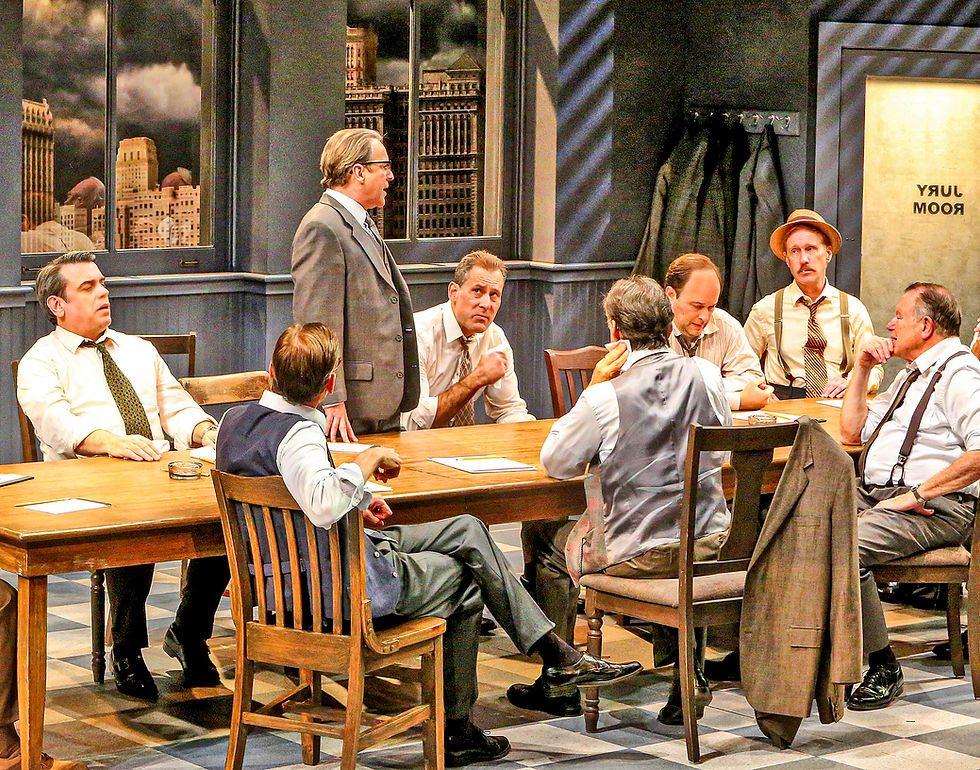A must-see ‘Twelve Angry Men’ at Palm Beach Dramaworks
- Robert Hagelstein
- Dec 14, 2022
- 7 min read

Bottom: Bruce Linser Juror 12, David Kwiat Juror 11, Rob Donohoe Juror 10, Top: William Hayes Juror 3, Gary Cadwallader Juror 4, Jim Ballard Juror 5, Matthew Korinko Juror 6 and John Leonard Thompson Juror 7.
Photo by Palm Beach Dramaworks.
The current production of the classic play “Twelve Angry Men” is one of the finest productions in Palm Beach Dramaworks’ long history of excellent offerings.
Here is a true ensemble effort, a PBD reunion of the finest male actors who have graced its stage over the years. Maybe it’s the times, or the intensity of this play with its realistic, fast-paced dialogue, or the size and brilliance of the cast playing off one another, or the inspired direction, but the gestalt is a passionate, stunning production running through Dec. 24 that would hold up on Broadway. It is an emphatic statement that live theater is back.
Seen against our time when democracy itself has been under siege, this production takes flight with new meaning, perhaps even more relevant today than when it was written by Reginald Rose as a teleplay in 1954, then adapted for the stage and ultimately becoming the 1957 film.
As a courtroom drama, “12 Angry Men” is unique because it does not take place in the courtroom. It unfolds during the deliberations of the jury, the courtroom details becoming clearer through the eyes of the 12 men with the responsibility of possibly condemning a 16-year-old boy to death for the killing of his father. The lapidary character performances by this all-star cast expose the jurors’ personality traits and deep-held prejudices in this gripping, nearly two-hour performance.
A jury is supposed to be composed of one’s peers, but the all-white, male jury of the play was Rose’s statement that the jury pools of NYC in the 1950s were typically not gender- or race-inclusive. This production again raises the issue of whether an accused can receive a trial by an impartial jury of one’s peers. Although today we have greater inclusiveness, political divisiveness is heightened.
As the house lights go down, we see the empty, neglected courtroom and hear a steady, one-note musical tone and the offstage judge ominously charging the jury: “I urge you to deliberate honestly and thoughtfully. If there is a reasonable doubt, then you must bring me a verdict of not guilty. If, however, there is no reasonable doubt, then you must, in good conscience, find the accused guilty.”
As the door to the jury room is opened by the guard, played by Cliff Goulet, the jurors file in from the courtroom.
Informal chatter as they find seats and the first show of hands reflect an initial rush to judgment. The jurors have other things to do, and as the defendant is “one of those people,” he’s probably guilty.
Just one stalwart, level-headed juror, the play’s protagonist, Juror 8, faultlessly played by Tom Wahl, stands alone in not rushing to judgment and in embracing his character’s profound responsibility, assimilating what the judge dispassionately said offstage.
He is the fulcrum ultimately bringing all the other jurors to question a guilty verdict with “reasonable doubt” hanging in the stale hot air of the jury room. Wahl’s performance is driven by his character’s patience and sense of impartiality.
The foreman, Juror 1, played by Tim Altmeyer, struggles to keep peace in the jury room while trying to count and recount votes, finally angrily (everyone gets his turn to be angry) throwing down the gauntlet and challenging someone else to be foreman.
A formidable antagonist to Juror 8 is Juror 10, portrayed by an explosive Rob Donohoe. He delivers a powerhouse performance displaying inbred racial prejudices with increasing ferocity throughout the play. At first he is just perplexed that Juror 8 is the only one voting not guilty, exclaiming, “Boy, oh, boy! There’s always one!” (The irony is not lost on the audience that it takes only one.) Nonetheless, his other antics bring needed humor into the jury room.
Juror 8 has another implacable opponent, Juror 3, who has a sad backstory of estrangement from his son. This challenging part is played by the producing artistic director of PBD, William Hayes, in his first time onstage in almost 20 years.
Hayes demonstrates he still has the right stuff to perform the strong-willed, single-minded juror who again and again swears he can never be convinced of the defendant’s innocence. He is a bully, and his personal history drives his thinking. Hayes seethes, consumed by a belief in the boy’s guilt and pitiable in his final capitulation.
John Leonard Thompson deftly plays the impatient, wise-cracking and opinionated Juror 7. His attitude could be summed up as “Guilty, I got a ball game to get to! The whole deal is a waste of time!” This contrasts to Juror 11, a European refugee played by David Kwiat with dignity. It is 11 who later ironically (as an immigrant) reminds his fellow jurors of their sacred responsibility, derived from the Constitution.
Dennis Creaghan (Juror 9) does not say much at first, astutely playing the elder statesman, one who notices things and brings the wisdom of his years to the jury room. Those observations are also a form of introspection as he comments on one of the elderly witnesses: “Nobody knows him. Nobody quotes him. Nobody seeks his advice after 75 years. That’s a very sad thing, to be nothing. A man like this needs to be recognized, to be listened to, to be quoted just once.”
His wisdom conflicts with the robotic rationality of Juror 4. Gary Cadwallader meticulously portrays a man of wealth, someone who thinks he sees things clearly. His is yet another pivotal role played with great skill.
Even the more minor parts have critical roles in the slow sway from guilty to not guilty. Michael McKeever (Juror 2) is a timid man whose opinion is easily altered by the others but is always adeptly in character, as is Jim Ballard (Juror 5), who hangs back for a while and finally comes forth with insight into the use of a switchblade knife, having come from the slums himself.
Matthew W. Korinko (Juror 6) carefully listens to his fellow jurors. He provides no particular insight but is among the first to change his vote and to defend other jurors who are verbally or even physically threatened.
Bruce Linser (Juror 12) convincingly plays a supercilious advertising executive who is imbued with self-importance but will easily follow others’ lead. It’s a key role as his vote wavers back and forth, almost a stand-in for the audience. After all, as Juror 8 acknowledges, the conjectures being made are not necessarily true, and it’s possible they will set a murderer free, but the evidence doesn’t seem to rise beyond a reasonable doubt.
The drama exposes truths about the characters’ personalities that quickly become more central than the details of the case itself. Step by step, they go from one “not guilty” to a unanimous “not guilty” as prejudices, obduracy and uncertainty yield to reason or merely exhaustion.
J. Barry Lewis superbly directs this production and takes his queues for orchestrating the action from the text of the play, sometimes flowing onto sidebars between certain jurors while the others are not involved. He finely tunes the performances so all the jurors stay in character even when not speaking, body language and looks revealing inner personas. He also capitalizes on what humor there is in the play for relief. Mainly, though, he draws the audience into this self-contained bubble on the hottest day in August, with the rising temperature and emotions palpable.
Physical threats and confrontations almost lead to violence as the play intensifies, and Lewis, with the help of David A. Hyland, the fight choreographer, makes the most of impending physical confrontations and a few frightening moments in which a switchblade is brandished. All of this takes place in real time, a working clock hanging on the wall, and although the jurors make reference to time, to the audience it flies by.
Scenic design is by Victor A. Becker, who has created a metaphor for the justice system. The courtroom is tired, one of the 12 overhead lights is out, the chairs don’t match, the floor is worn. Outside three large, double-hung windows one can see the Woolworth Building and other buildings of that time in seemingly 3D relief against an angry sky. It is the ideal pressure cooker into which the jurors (and we) are locked.
Kirk Bookman’s lighting design has realistic, cutting-edge lights on the jurors, trapped in their deliberations, while sidelights and lighting beyond the windows illuminate the rainstorm that falls during most of the second half of the play.
Costume design is by the always artistic and inventive Brian O’Keefe, and although there are no costume changes, there are 12 distinctive attires, mostly suit jackets and ties being removed and sleeves rolled up as the play unfolds and the heat builds. Little details, like who should wear wedding rings and hairstyles, reflect each character.
Sound design by Roger Arnold focuses on hidden mics for the actors, who sometimes have their backs to the audience when occasionally sitting around the table (although even then, Lewis has them sit at slight angles for audience viewing). “Music” is a drone at the beginning that reprises slightly differently at the conclusion. During the few quiet moments in the jury room, some NYC sounds can be heard, as well as ominous thunder as the storm hits and windows are hastily closed.
Toward the play’s denouement, we are reminded about how little things change. Near exhaustion, Donohoe (Juror 10) delivers what could pass as “today’s news” about “replacement theory,” saying, ”Don’t look at me like that! There’s a danger. For God’s sake, we’re living in a dangerous time, and if we don’t watch it, if we don’t smack them down whenever we can, then they are gonna own us. They’re gonna breed us out of existence.”
After those chilling, fervent lines, Donohoe retires to a chair as an exhausted, sweaty mess. It takes Wahl’s Juror 8 to break the tension, compassionately saying, “It’s very hard to keep personal prejudice out of a thing like this. And no matter where you run into it, prejudice obscures the truth.”
How prescient this play was and is, brilliant in its conception and presentation by one of the leading regional theater companies in America. It should not be missed.
For more information or tickets, visit palmbeachdramaworks.org, or call 561-514-4042.











Comments